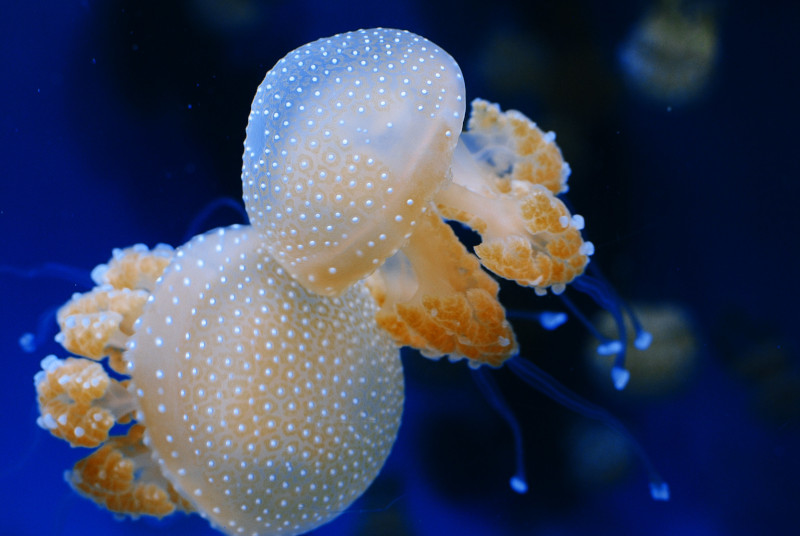
White-spotted Jellyfish Facts
- This marvelous marine wonder most frequently goes by the descriptive common name of the White-spotted Jellyfish for obvious reasons. Yet it also has several other titles, too. A few of these include floating bell, Australian spotted jellyfish, and brown jelly.
- Inside of the scientific community, however, it’s perhaps better known by its technical epithet. Unfortunately, as so often holds true, that’s a somewhat difficult tag for the layperson to pronounce. That’s because it bears the formal label Phyllorhiza punctata.
- The remarkable creature received that appellation due to the efforts of Robert J. Lendlmayer von Lendenfeld. The respected Austrian zoologist accomplished the first acknowledgement of it as a separate and distinct species. He managed that in 1884.
- Pleasantly, the White-spotted Jellyfish appears to be maintaing a population base that’s both stable and sufficient. That fortunate situation also seems to hold true throughout the entirety of its range. The IUCN thus currently has no listing for the Cnidaria.
- The wonder of Nature nevertheless likely faces several threats to its existence as a species. Many of these stem from the actions of mankind, and form the same perils most creatures face. They include such dangers as habitat loss and climate change.
Related Articles
White-spotted Jellyfish Physical Description
The truly mesmerizing White-spotted Jellyfish quickly captures the attention of those individuals lucky enough to meet one in the wild. This marvel of evolution typically does so, though, due more to its appearance than size. That’s true since it’s not a large species.
Like most animals around the world, it also displays the physiological characteristic of sexual dimorphism. In its case, however, the gender-based difference remains so minor that it’s virtually impossible for the average observer to distinguish the two sexes at a glance.
Mature specimens of both sexes attain the same physical dimensions and structures. This includes a rounded disc that reaches a maximum known diameter equaling roughly 20 in (50 cm). Most encountered examples of the natural wonder, though, never quite reach this.
Suspened from underneath that bell, however, it displays a total of eight branching oral arms. These appendages tend to be relatively thick in structure, and end in large brown bundles of stinging cells. Each of these also usually develops as principally transparent.
Yet, it’s the color pattern of the amazing White-spotted Jellyfish that catches the eye. It’s also the source of the primary common name. The main body of the animal generally presents a background of bluish-brown, with numerous, evenly distributed opaque white spots.
- Kingdom: Animalia
- Phylum: Cnidaria
- Class: Scyphozoa
- Order: Rhizostomeae
- Family: Mastigiidae
- Genus: Phyllorhiza
- Species: P. punctata
White-spotted Jellyfish Distribution, Habitat, and Ecology
Evidence indicates that the stunning White-spotted Jellyfish evolved as native to a comparatively large swathe of the marine regions of the world. That original zone of habitation won’t surprise many people, though. It’s an area teeming with similar marvels.
That’s because the Cnidarian apparently developed as endemic to the western Pacific Ocean. There, the animal lives natively from the waters around Japan to those near Australia. Now, however, it’s been spread to many other regions due to the actions of mankind.
Within that greater territorial range, though, the animal displays distinct tendencies regarding its choice of habitat. Intriguingly, however, these present as both broad and precise simultaneously. The result leaves them with a moderately limited choice of locations.
That’s due to a combination of two primary factors. Overall, the jellyfish resides in both coastal waters and regions further out to sea. Yet, in all these zones, it only remains close to the top of the water column. It’s not known to appear at depths beyond 164 ft (50 m).
Like most of its relations, the White-spotted Jellyfish possesses venom in its stingers. This, though, isn’t strong enough to kill prey. The species therefore evolved to feed via filtering. Understandably, it’s primary food source consists of vast amounts of zooplankton.
Once again maintaining the patterns of its kind, the animal has two stages of life. These consist of the polyp and the medusa. But incredibly, the creature’s capable of reproduction in either stage. Among the first that’s asexually, while in the second it’s sexually.
Species Sharing Its Range
Check out our other articles on 5 Rare Mind-Blowing Cloud Types, Eastern Gray Squirrel, Lake Atitlan, Snowflake Moray, Agile Ground Mantis, Fire Salamander, Strawberry Tree, Philippine Cobra
